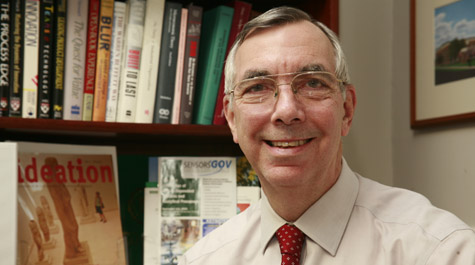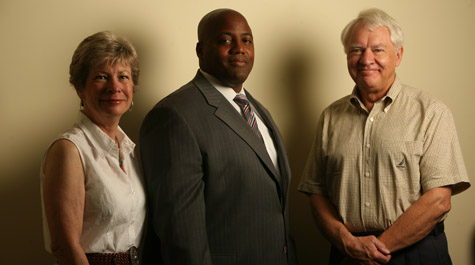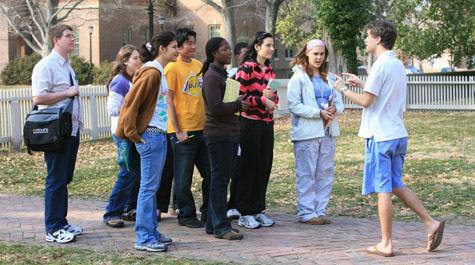W&M plays large role in economic diversification report
William & Mary played a significant role in the Historic Triangle Collaborative’s Economic Diversity Task Force, which released a report of its recommendations in September 2010 after a year of research and discussion.
The report seeks to find mutually beneficial ways in which James City County, Williamsburg, York County and other major institutions can work together to diversify the Historic Triangle’s regional economy while also strengthening the tourism industry. Much of the report emphasizes the importance of supporting entrepreneurs, small businesses and young professionals and creating an environment that is conducive to opening new businesses or expanding current ones.
The task force, which was convened in August 2009, was led by Jim Golden, vice president for strategic initiatives at William & Mary and immediate past chairman of the Greater Williamsburg Chamber & Tourism Alliance. Leonard Sledge, the College’s director of economic development, also served on the task force. The task force included the directors of economic development and the chairs of the economic development authorities for the three localities as well as representatives from the Colonial Williamsburg Foundation, the Greater Williamsburg Chamber and Tourism Alliance, Thomas Nelson Community College, Kingsmill Resort & Spa, and the Historic Triangle Collaborative.
Golden explained that although the tourism and hospitality sector of the regional economy has been growing over the past two decades, the sector was hit hard when the national economy took a downturn beginning in 2007.
“There’s a general interest in what we can do to diversify the economy and make it less vulnerable to downturns in any one sector. We certainly want to have a strong tourism and hospitality sector, but it would be good to expand in other areas as well where we have strengths and where we can attract and grow businesses,” he said. “We think William & Mary can play a strong role in helping the region do that.”
The task force report lists six major goals, including: leveraging the location of Williamsburg between Richmond and Hampton Roads, engaging in collaborative economic development planning, providing a support system for entrepreneurs, using major institutions to support economic initiatives, creating a regional business brand and diversifying the tourism industry’s offerings.
Sledge said the College is particularly interested in three aspects of the goals: entrepreneurial assistance, joint business marketing and tourism.
“William & Mary is a major economic driver in the Historic Triangle,” Sledge said, noting that the College accounts for about half a billion dollars in economic activity in the state and approximately 7,000 jobs. “We have research facilities, we have other types of venues … we are very much a part of the fabric of the regional economy. So we need to continue identifying things we can do to help grow the region from an economic development standpoint outside of just having students come and be part of our campus.”
Entrepreneurs
Sledge noted that both the Historic Triangle and Hampton Roads have identified entrepreneurship as “being central to building the economy.”
“I think we all recognize the strength that entrepreneurship plays in individual communities and at the same time the wealth of knowledge and expertise that exists,” he said. “In terms of what’s here, the people that are here, I think we have a solid base to build on for entrepreneurship, and that’s not just technology-based entrepreneurship. That’s entrepreneurship of all shapes and sizes.”
One of the ways William & Mary already assists local entrepreneurs is through the James City County Business and Technology Incubator. William & Mary began managing the incubator last year, and it has thrived under the leadership of Bill Bean, director of the College’s Technology and Business Center, said Golden.
The incubator provides entrepreneurs not only a place to conduct business but also a comprehensive assistance program that includes business planning, mentoring and connections with professors and students.
The report suggests transforming the current incubator into something that can serve all three localities in the Historic Triangle.
“We’d like to help the jurisdictions explore whether that should be expanded to be a regional incubator because it’s hard to predict exactly where the companies that come out of the incubator are going to go,” said Golden.
In addition to the incubator, local small businesses and entrepreneurs are also receiving help from the College via the Mason School of Business’ new entrepreneurship center, which offers new ways to connect faculty and students with companies in the area.
Faculty in many departments, particularly applied science and marine science, are also working with local companies, a partnership that will expand even more when part three of the College’s Integrated Science Center is built.
“It’s going to be the section with more of the applied labs, so that will promote linking our research to potential business applications,” said Golden.
Tourism
Monty Mason, a 1989 graduate of the College and chairman of the Williamsburg Economic Development Authority, said that the region’s economy is largely dependent on and driven by tourism, and so officials are always looking for ways to drive visitation numbers higher. But they also want to look at other opportunities and ways to diversify the economy.
“We know we’ll never supplant tourism as being the main driver, and we don’t want to, but at the same time, there are things that seemingly can be done,” he said.
While the region looks at whether new tourist attractions are needed and how current attractions can improve, William & Mary is considering how it can help promote and support the local tourism industry as well as how the College’s own attractions can be leveraged as tourism opportunities.
President Taylor Reveley recently created a Tourism Task Force to address these questions and their related issues. Sledge co-chairs that task force with Carloyn Davis, director of auxiliary services at the College.
According to recent research, well over 100,000 people visit the College per year.
“We know that we attract lots of aspiring students and their families and alumni who come back,” Sledge said, “but how can we better define our role in the tourism landscape so that we can add value to what’s already happening and at the same time try to capitalize on our opportunities as well?”
Joint marketing
Just as the report calls for collaboration in supporting entrepreneurs and attracting and increasing tourism, it also calls for businesses to work together on marketing. The task force examined whether there were opportunities for the three economic development offices to work together in selling the Historic Triangle even though they are competing to try to attract companies to locate within their area’s boundaries.
“The concept was that we probably can do more in terms of regional marketing in an attempt to get companies to the area and then let the three jurisdictions compete,” said Golden.
The idea of joint marketing led to the question of how to describe the region to potential businesses.
“The localities – Williamsburg, James City County and York County – do work well together in terms of economic development opportunities,” said Sledge. “However, there is no consistent business brand for the region.”
Although the three localities are known as the Historic Triangle, the task force thought that title doesn’t convey everything the area has to offer to potential businesses.
The task force also suggested that part of the new marketing strategy include a shift in the way the area is geographically viewed. Traditionally, the Historic Triangle has been thought of as the northern- or western-most point of Hampton Roads.
“That’s caused us to be outliers, especially when you begin to think about the traffic and transportation challenges we have in the region” said Sledge.
The report suggests the area begin thinking of itself and marketing itself not as on the edge of Hampton Roads, but as halfway between Hampton Roads and Richmond.
“What that does is expand the market for companies who are looking for a hub of operations to serve both metropolitan areas,” said Sledge.
Moving forward
Through their year-long review process, the task force asked numerous local businesspeople and other citizens for their input.
“We really got a broad range of people to come in and give us their perspective on the area and what they thought might work out. It was a very fascinating committee to be on,” Mason said.
“We had an incredible range of participants on the committee, but more importantly, people coming to talk to us about what’s going on and what they’re seeing.”
Once the report was complete, the task force presented it to the Historic Triangle Collaborative which then distributed it to its member organizations so they could review it and begin volunteering to take up some of the initiatives suggested. That process is still ongoing, but will likely inform the comprehensive planning process that will be taken on by the three localities in 2012.
“I think the report was a good start,” Mason said. “Now, we’re meeting quarterly to keep momentum and discuss some opportunities among the individual localities – who can drive what, who can focus on what – and just try to keep it moving forward.”
Golden said he is pleased with the work that the task force did over the last year.
“We got a lot done in a fairly short period of time,” he said. “We provided a good background for the 2012 comprehensive planning process. I think we helped to either launch or expand conversations about where we would like our economy to go, particularly to focus on smaller businesses and entrepreneurship and young professionals and groups that can expand the opportunities that are available here.”
 Skip to main content
Skip to main content



